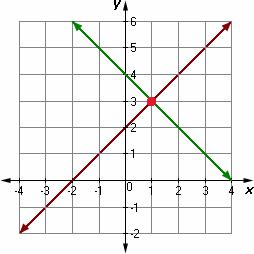Which method would be best to solve the system below? (Graphing, Substitution, or Elimination)
x = 2
2x + 3y = 13
Substitution
x is already solved!
Plug in 2 directly in for x and solve for y!
When two equations are graphed, where is the solution?
Where the lines cross each other.
Solve the system by Substitution method:
y = -2
4x - 3y = 18
(3, -2)
4x - 3(-2) = 18
4x = 12
x = 3
Solve the system using Elimination method:
x - y = 11
2x + y = 19
(10, -1)
Get rid of the y by adding!
3x = 30
x = 10
Is (-1, 1) a solution to the system:
y = x - 2
2x + y = 1
No
y = x - 2
1 = (-1) - 2
1 = -3 Not true!
Which method would be best to solve the system below? (Graphing, Substitution, or Elimination)
y = -3x + 2
6x + 2y = 1
Substitution
y is already solved for, just plug it in!
If the system of equations is graphed with two PARALLEL lines, how many solutions are there?
No Solution, One Solution, or Infinitely Many Solutions
No Solution
The lines don't cross!
Solve the system by Substitution method:
2x - 3y = -1
y = x - 1
(4, 3)
2x - 3(x - 1) = -1
-x + 3 = -1
-x = -4 ---> x = 4
Solve the system by using the Elimination method:
-6x + 5y = 1
6x + 4y = -10
(-1, -1)
Get rid of x by adding!
9y = -9
y = -1
Is (-4, 7) a solution to the system:
y = -2x - 1
x + y = 3
Yes!
7 = -2(-4) - 1
-4 + 7 = 3
Both are true!
Which method would be best to solve the system below? (Graphing, Substitution, or Elimination)
3x + 2y = 4
-3x + y = 2
Elimination
Get rid of the x by adding!
What is the solution to the system graphed below?

(1, 3)
x = 1, y = 3
Solve the system by Substitution method:
y = x
y = -x + 6
(3, 3)
x = -x + 6
2x = 6
x = 3
Solve the system by using the Elimination method:
4x + 2y = 8
3x + 2y = 6
(2, 0)
Get rid of the y by subtracting!
x + 0 = 2
x = 2
Is (4, 7) a solution to the system:
y = -2x - 1
x = -y + 3
No!
7 = -2(4) - 1 = -8 - 1
4 = -7 + 3
Neither one works
Which method would be best to solve the system below? (Graphing, Substitution, or Elimination)
y = 1/2x + 2
y = 2x - 7
Graphing
Both equations are in y = mx + b form!
(Substitution could also work here)
What is the solution to the system graphed below?

No Solution
Parallel lines don't have a point of intersection!
Solve the system by Substitution method:
y = 5x - 1
2y = 3x + 12
(2, 9)
2(5x - 1) = 3x + 12
10x - 2 = 3x + 12
7x = 14
Solve the system by using the Elimination method:
-3x + 3y = 3
-3x + 6y = -12
(-6, -5)
Get rid of the x by subtracting!
-3y = 15
y = -5
Is (2, -1) a solution to the system:
y = 1/2x
y = -x + 3
Nope.
-1 = 1/2(2)
-1 = -2 + 3
Neither of these are true.
Which method would be best to solve the system below? (Graphing, Substitution, or Elimination)
4x + y = 16
2x + 3y = -2
Elimination
Multiply the bottom equation by -2
(Or Substitution; Solve the first equation for y)
Does the system below have one solution, no solution, or infinitely many solutions?
y = 2/3x + 11
y = 2/3x - 4
No Solution
The slopes are the SAME, so the lines are PARALLEL
No point of intersection
Solve the system by Substitution method:
-5x + y = -3
3x - 8y = 24
(0, -3)
y = -3 + 5x
3x - 8(-3 + 5x) = 24
3x + 24 - 40x = 24 ---> -37x = 0
Solve the system by using the Elimination method:
5x + y = 9
10x - 7y = -18
(1, 4)
Multiply the top equation by -2
-10x - 2y = -18
10x - 7y = -18 ----> Then add!
Is (3, -1) a solution to the system:
x - 2y = 5
2x - y = 7
Yes!
3 - 2(-1) = 3 + 2 = 5
2(3) - (-1) = 6 + 1 = 7
Both are true!